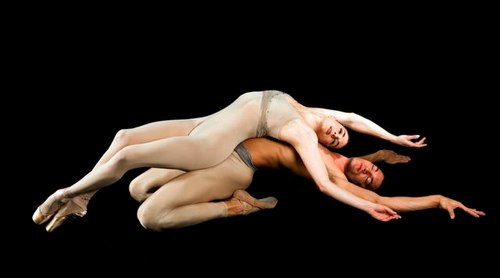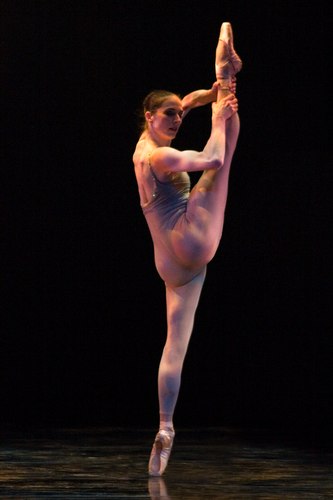|
 |
|
|
 |
 |
It was the tops! In an evening of simply the best of the best productions and performances, The Joffrey Ballet, in its 50th year, brought out one incredible piece after another. This was a night to be remembered forever by anyone fortunate enough to see Light Rain. During a pre-performance reception, Jason Tyler, representing the event sponsor, Portfolio Management for Ariel Capital Management, Inc., spoke of diversity and people who, "…look for difference as a sign of creativity," a statement well-applied to the performances to come. Dance for Yal: (World Premiere: Zaccho Dance Theatre, 1985, Joffrey Premiere: 1996), Choreography by Joanna Haigood, Vocals by Edith Piaf, Music and Lyrics by Pierre Brasseur and Michel Emer ( Et Pourtant), Costume by Joanna Haigood, Lighting by Kevin Dreyer after the original Howell Binkley design, performed by Maia Wilkins Suspended upon a trapeze, at the height of the ceiling, stage left, the inimitable, Maia Wilkins, swings outward toward the audience, slicing diagonally like a blade, before she is lowered to a fog-dusted stage. In her heart-red gown, trailing her languorous form, she hangs from the bar, like a woman clinging to the arm of a lover. Because her movements, as always, are impeccably unencumbered, and only look effortless because of her strength and skill, they cut like the lyrics of the Piaf song. A woman may take the leap of hope and give herself utterly to love, et pourtant, and yet…there will always be something dark waiting to spoil the pleasure. A thrilling opening to the pieces of Light Rain, Dance for Yal shattered the ice as the first of two aerial works. Staged with nothing to distract from the ebb and flow of Ms. Wilkins' arcing movements, she, like a red moth about to be consumed by flame, pinned the audience to her poignant solo. Untitled: (World Premiere: Pilobolus, August 1975, Joffrey Premiere: September 26, 1985), Courtesy of Pilobolus, Choreography by Robby Barnett, Alison Chase, Maratha Clarke, Mosses Pendleton, Michael Tracy, Jonathan Wolken, Music by Robert Dennis, Costumes by Malcolm McCormick, Costume Supervision by Sally Ann Parsons, Lighting by Kevin Dreyer after the original Thomas Skelton design, Performed by Jennifer Goodman, Britta Lazenga, William Hillard, Eduardo Permuy, Aaron Rogers, Michael Smith Anyone who's ever seen a Pilobolus composition would immediately recognize Untitled for one of that company's pieces. It had sly humor. It had right-brained body contortions. It had the element of surprise. And, it had the Joffrey doing it all just right. Two aberationally tall women, preening and grooming one another, looking oddly like folk art paintings in their jersey dresses and swooping movements, are not really tall as giraffes after all! The skirts of the costumes are drawn back to reveal men underneath who appear to be baby butt naked, rocking them from side to side. It's a birth scene! Each is actually perched upon the shoulders of a man, hidden beneath her dress, and like those children's puzzles that interchange body parts for ridiculous effects, the men's legs playfully cavort under the skirts. Sometimes they face forwards with the torsos and heads of the women topping the forms, sometimes they are turned backwards with the women's heads facing front. It is a completely disconcerting mixing of gender specific parts and orientation, and the ease with which the dancers manage the ups and downs and turn arounds is part of the skill and fun. Inevitably, there is a challenge to the gently swaying and coalescing pairs, a couple of ice cream suited dandies picks a fight with the "baby" men, and the women quell the hostility by enveloping them with their voluminous skirts for a dream-like end. White Widow: (World Premiere: MOMIX, September 1995, Joffrey Premiere: June 10, 2000), Choreography by Moses Pendleton and Cynthia Quinn, Music by Angelo Badalamenti, Lyrics by David Lynch, Costumes by Cynthia Quinn, Lighting by Kevin Dreyer after the original Bruce Goldstein and Moses Pendleton design, Performed by April Daly. Like a rag doll with not enough stuffing, April Daly hung suspended from a trapeze, her arms threaded through loops behind her, as Angelo Badalamenti's, "The World Spins," vibrated with melancholy chording. Another off terra piece by the Joffrey, I saw the premiere of White Widow on a frigidly cold night at Ravinia when Emily Patterson debuted this emotionally affecting work. I've never stopped thinking about the dance, its visual text, how moved I was. It requires strength and courage to perform airs above ground, as it were, and the dripping sadness of the lyrics call for a dancer whose body can express the mournfulness of a woman begging, "Love don't go away/Come back this way/Come back and stay/Forever and ever/Please stay." The lyrics are barely, if that, intelligible, like thoughts, a few words of which are murmured aloud. The long white dress of the dancer, floating in the glide of her swing, is like a ghostly image marking where she has been. Ms. Daly is suspended in some interior place of mourning. Her foot traces a circle on the light dappled stage; she is lost in reverie. Lowering herself into a horizontal pose that practitioners of Pilates would wish to emulate, she twirls around and around looking like the volunteer in a magician's levitating woman trick. Letting go and holding on are conflicting forces as she clings and draws herself into a fetal position all the while supporting herself on two filaments of rope. The dancer pulls herself upwards and using the loops and upper body control, cartwheels over and over. She runs a few steps, is swept back by her ropes and runs again. She is empty and limp as the light fades and she twirls. Valentine: (World Premiere: The Joffrey Ballet, March 10, 1971), Choreography by Gerald Arpino, Music by Jacob Druckman, Lighting by Kevin Dreyer after the original Jennifer Tipton, Solo Contrabass by Joseph Guastafeste, Performed by Jennifer Goodman and Brian McSween. Oh, here's a howdy do! The contrabassist wears a referee's striped jersey as he plucks slurry notes and the two dancers stand in diagonal corners like two contenders in their pre-fight robes. It's the battle of the sexes, orchestrated with vocalizations, facial expressions with costumes and top knots looking like cartoons of Lautrec caricature. Goodman and McSween feint and spar; one's up when the other's down. Will they ever get together? She teases him with her insouciance and wide splits. He turns his back. She attacks. He holds her in place, putting his hand against her forehead and keeping her at arm's length. She takes a run at him and he holds her vertically. She does a headstand which unfolds into splits, and the fray continues until they collapse together in a heap, cartoons at last getting together. Caught: (World Premiere: Parsons Dance in 1982, Joffrey Ballet of Chicago Premiere: March 27, 1999), Choreography by David Parsons, Music by Robert Fripp, Staged by Charthel Arthur after David Parsons, Lighting Concept by David Parsons, Lighting by Kevin Dreyer after the original Howell Binkley design, Costumes executed by Rebecca Shouse, Performed by John Gluckman, Production Sponsorship by Sara Lee Caught refers to the exact moment the eye registers the apex of a dancer's movements, time after time, as he takes a grand tour around the degrees of a circle. Freezing the instant in a blast of strobe lighting that illuminates an otherwise dark stage, the experience is like back breeding a camera to silent film vintage with its herky jerky timing. Seemingly, no movement we can see connects the height of one leap with that of another as the dancer races unseen to meet the next appointed flash of light. But that is not exactly accurate. One's brain fills in the steps in between, the speed of the dancer throwing himself from one spot to another, the pounding heart, the breathing, the sweat power and accuracy which join in one accurate instant. Perfectly timing his laps around the stage with the pulses of light, John Gluckman epitomized strength and precision. At times, the stop-motion effect made it appear he was walking on air, and if one's eyes were to be believed, that is just what he did. His standing ovation was an emotional response to his extraordinary performance. Light Rain: (World Premiere: The Joffrey Ballet, November 4, 1981), Choreography by Gerald Arpino, Music by Douglas Adamz and Russ Gauthier, Costumes by A. Christina Giannini, Lighting by Kevin Dreyer after the original Thomas Skelton design, Production Sponsorship by N.I.B. Foundation, Performed by Maia Wilkins and Michael Levine with Derrick Agnoletti, April Daly, Jonathan Dummar, William Hillard, Anastacia Holden, Britta Lazenga, Alexis Polito, Mauro Villanueva, Joanna Wozniak It's tropical and tribal and like watching golden-clad primitives in smoky rays of light worship idols as drums, cymbals, and sticks accompany the massive three movements. Maia Wilkins and Michael Levine are featured in sensuous pas des deux, the chemistry and partnership of the pair electrifying to watch. She is a goddess whose arms undulate to the Asian tones of the music as he bends her backwards, supports her hyper extended leg, pulls her across the stage, her gaze locked onto his eyes. He reclines, supporting her only with his arms as face to face, they cradle like an emblematic lotus blossom. The corps returns and the popping sounds of an electric violin, like spots of water hitting a hot griddle, impel them into small groups joining and breaking apart until the whole joins at stage center, reaching and grasping towards the sky. An exhaustive and varied program, Light Rain was a magnetizing conclusion for the season.
 Dance For Yal
Maia Wilkins Photo © & courtesy of Herbert Migdoll |
|
 Light Rain Photo © & courtesy of Herbert Migdoll |
|
 Light Rain Photo © & courtesy of Herbert Migdoll |
|
 Untitled Photo © & courtesy of Herbert Migdoll |
|
 Valentine Photo © & courtesy of Herbert Migdoll |
|
 White Widow Photo © & courtesy of Herbert Migdoll |
|
 Affinity Night Reception before Light Rain Photo © & courtesy of Herbert Migdoll |
|
 Valerie Robin in Light Rain Photo © & courtesy of Herbert Migdoll |
|
|
|









